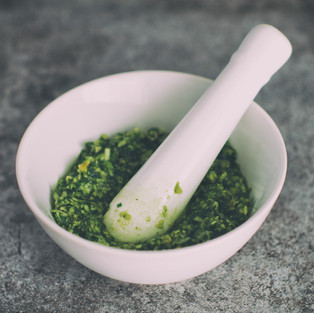A Few Words About Herbs
- Chef Savant

- Mar 11, 2020
- 3 min read
Updated: Mar 1, 2023
Herbs can offer a variety of ranges to developing flavor in foods. Here we take a look at a few basic differences and applications to understand when and how to use them!

There’s certainly no shortage of ingredients to pull from whenever one decides its time to channel their inner chef and create a meal. For some recipes, even the smallest additions or omittance can make all the difference in the final flavor outcome. The overall defining finish of a dish can be changed with just the simplest addition of herbs, fresh or dried, which can change the range on the finish to subtle, bold, fresh, aromatic, earthy or even savory.
In point of fact, some of the best components for elevating recipe flavors are non other than quality herbs, which are basically plant leaves. These leaves come from delicious plant varieties such as mint, parsley, basil, rosemary, oregano, thyme, sage, bay leaves, kieffer lime, cilantro, and dill, just to name a few but, there are many others out there. On their own these fresh herbs can pack a lot of flavor and create a signature affect in items such as, fresh salsa, pesto, chimichurri, or simply just being used as a garnish.

In some cases you only have to break or rub the leaves to collapse some of its fibers before adding them to a dish. However, other herbs can give new meaning to a meal by becoming more prominent when they are toasted or heated, which is why you may sometimes notice a chef toss something like rosemary or thyme in a pan with fresh garlic allowing the herbs to “bloom” when cooking a piece of steak or fish. The reason for this is because when heated, these herbs will open up and release oils and aromatic affects locked within the leaves and stems.
From time to time, it can be confusing to understand when or why to use of fresh herbs over dried ones. Contrary to popular belief the potency of dried herbs can out weigh that of fresh herbs by as much much as a 3:1 ratio, in addition to boasting a significantly longer shelf life as well. However due to the nature of the way our tastebuds perceive potency, fresh herbs tend to pack more of a punch because the flavors SEEM more pronounced than the dried herbs, because of the water content found within the leaves. Still, dried herbs do have their place in the kitchen, and in part due to the slow release of their flavors, they often work best in simmered dishes like stews, porridges, and soups; or if you’re a really advanced culinarian, you might try using dried herbs when creating things like spice blends, marinades, or spiced sugars and salts. (We’ll discuss spice blends and salts in a later post.)
In addition to being a great food partner, herbs also find infinite uses in a variety of drinks and cocktails. Most notably the herb that everyone recognizes for drink uses are fresh mints; spearmint, chocolate mint, peppermint, lemon mint, etc.. In some cases mixologists will use a method called infusing, by mashing or muddling herbs to extract and distill the herbal flavor into a concentrate or simple syrup and then proceed by adding said concentrate or syrup into a drink or into ice cubes before adding them to a drink. In addition to mints though you can also find cocktails enhanced by herbs such as shiso, verbena or lavender.
Historically herbs have enjoyed a variety of other applications in the form of medicinal uses, burial ceremonies, and even in water purification. They can be surprisingly easy to grow as well, even if you don’t have a green thumb. Some people simply buy a small planter and place it on a window seal and enjoy plucking a pinch of herbs daily to enhance their meals with a fresh finish, thereby making them a huge staple ingredient to keep around. And with dried herbs claiming their place as a pantry staple, they make perfect compliments for use in things like chili, pastas, and stews mentioned previously.
Conclusion
To put all of this into perspective, we’ll be featuring herbs in recipes in the weeks to come and we’ll also be entertaining your questions along the way to ensure that you have a great understanding of the culinary uses and the various applications for herbs, to enhance your personal culinary experience!











Comments